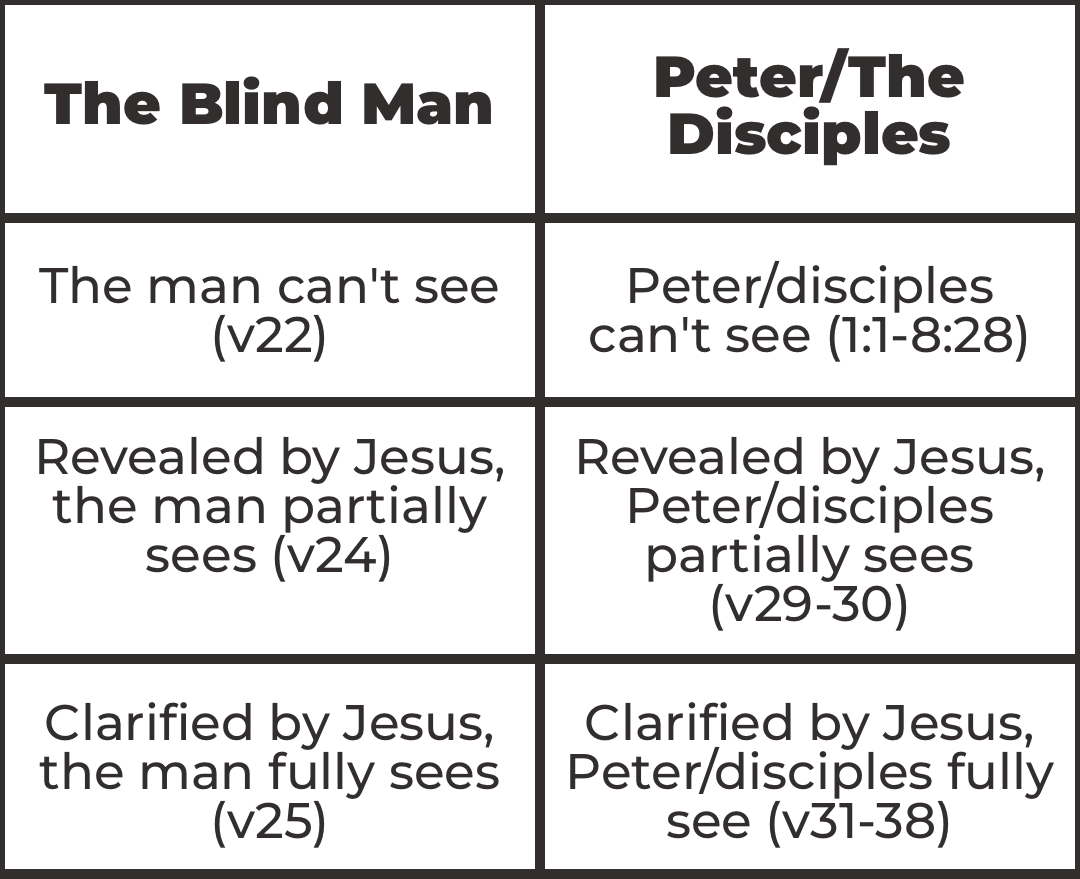Mark Vol. 2 - Week 7 (8:22-9:1)
Mark 8:22-9:1
〰️
Mark 8:22-9:1
〰️
Mark 8:22-9:1 〰️ Mark 8:22-9:1 〰️
In Mark 8:22-9:1, we're presented with a handful of short accounts. The first is a miracle, where Jesus heals a blind man and is followed by a few stories of Jesus speaking with his disciples. Mark's creative narrative choices in these passages highlight his overall focus on the Gospel account: "Who is Jesus?" While all of these events are also found in Matthew 16, the significance of the way Mark arranged them is what reinforces this question we've been asking throughout our study of Mark.
I've said this several times now, but we have to keep in mind that there are things and perspectives that we can and will lose when taking bite-sized chunks of an entire book week by week. Just like how we can focus on one measure of a song, we might know every note and instrument playing. But if we listen to only one measure or phrase at a time over a year, we don't hear the cohesion and uniform elements that the author intended. It's the same with the Gospels, and in particular, Mark's Gospel account. This book was written and organized so that it would be read aloud. Hearers would likely have been able to remember details that were mentioned less than ten minutes prior in the reading. But we lose this in how we're taking these passages in chunks. This isn't a bad thing at all, but something to keep in mind.
Back to the passage, we have four neat sections in a row. When reading this, we might think that the central focus of this section is the healing of the blind man, but it's actually meant to function as a real-life parable of sorts. In v22-26, Jesus encounters a blind man brought by friends. Jesus takes the man away and speaks with him. He asks the man what he sees, and the man says he almost sees clearly. Again, Jesus touches his eyes, and the man can finally see. The coolest part of this is that it's a summary of the passages that follow. Check out the chart below to see some of the parallels!
A man is blind and brought to Jesus (v22) -> Peter and the other disciples can't see who Jesus really is (1:1-8:28; basically, the entire Gospel narrative up to this point).
Revealed by Jesus, the man can partially see (v24) -> Slowly revealed by Jesus, Peter and the other disciples can partially see who He is (v29).
Further clarified by Jesus, the man can fully see -> Further clarified (and rebuked) by Jesus, Peter, and the other disciples see who He is (v31-38).
Up to this point in the narrative, we've seen the disciples "see" Jesus' miracles and teachings but still don't get who He is. They, like us today, stumble and fail. To this point, they don't fully understand who Jesus is. Then, in v27-30, Jesus asks them point blank who they think He is. Some disciples say a prophet, but Peter knows Him as the Messiah, the Christ. But Peter doesn't quite get it yet. He, and many others, expect the Messiah to come as a triumphant ruler who will wipe out all (Roman) oppression and rescue the people from earthly harm. However, Jesus' purpose and mission were to rescue His people from the oppression of sin and offer eternal life. This is the disconnect we see in v31-33. Jesus tells the disciples that His mission and purpose is to die, not conquer the world for the Jewish people. At this, Peter rebukes Him, and Jesus says, "Get behind me, Satan! You are not thinking about God's' concerns but human concerns." (v33). Peter shows that he still doesn't fully see.
In v34-38, Jesus further clarifies His purpose on earth and how it will play out. God's people should no longer expect to get out from under Rome's oppressive thumb and conquer the world. Instead, the Messiah came to serve, die, and resurrect, defeating sin and death along the way. The true enemy in the big picture is sin, not an earthly empire. In this, Jesus fully revealed to the disciples who He is and His full purpose. He does so for us, 2000+ years later. Our flesh can so often desire for God to remove pain and suffering in this world, but our LORD has His eyes set on eternity. He sees us in our suffering and joins us in them. Our LORD said, "in me you may have peace. You will have suffering in this world. Be courageous! I have conquered the world" (John 16:33).
Discussion Questions
What stood out to you from the passage?
Does anything in this passage remind you of another part of Scripture?
Do you have any questions?
Do you bring your friends to Jesus with the kind of faith in v22?
Why do you think Peter rebuked Jesus in v31-33? What do you think Peter misunderstood?
Who do you say Jesus is?
How does a story like this challenge your preconceived beliefs about Jesus? How do you typically respond to that being challenged?
How does this passage encourage us to have faith and find peace in suffering?

